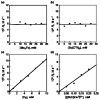Lewis acid-induced change from four- to two-electron reduction of dioxygen catalyzed by copper complexes using scandium triflate
- PMID: 25659416
- PMCID: PMC4630010
- DOI: 10.1021/ja512584r
Lewis acid-induced change from four- to two-electron reduction of dioxygen catalyzed by copper complexes using scandium triflate
Abstract
Mononuclear copper complexes, [(tmpa)Cu(II)(CH3CN)](ClO4)2 (1, tmpa = tris(2-pyridylmethyl)amine) and [(BzQ)Cu(II)(H2O)2](ClO4)2 (2, BzQ = bis(2-quinolinylmethyl)benzylamine)], act as efficient catalysts for the selective two-electron reduction of O2 by ferrocene derivatives in the presence of scandium triflate (Sc(OTf)3) in acetone, whereas 1 catalyzes the four-electron reduction of O2 by the same reductant in the presence of Brønsted acids such as triflic acid. Following formation of the peroxo-bridged dicopper(II) complex [(tmpa)Cu(II)(O2)Cu(II)(tmpa)](2+), the two-electron reduced product of O2 with Sc(3+) is observed to be scandium peroxide ([Sc(III)(O2(2-))](+)). In the presence of 3 equiv of hexamethylphosphoric triamide (HMPA), [Sc(III)(O2(2-))](+) was oxidized by [Fe(bpy)3](3+) (bpy = 2,2-bipyridine) to the known superoxide species [(HMPA)3Sc(III)(O2(•-))](2+) as detected by EPR spectroscopy. A kinetic study revealed that the rate-determining step of the catalytic cycle for the two-electron reduction of O2 with 1 is electron transfer from Fc* to 1 to give a cuprous complex which is highly reactive toward O2, whereas the rate-determining step with 2 is changed to the reaction of the cuprous complex with O2 following electron transfer from ferrocene derivatives to 2. The explanation for the change in catalytic O2-reaction stoichiometry from four-electron with Brønsted acids to two-electron reduction in the presence of Sc(3+) and also for the change in the rate-determining step is clarified based on a kinetics interrogation of the overall catalytic cycle as well as each step of the catalytic cycle with study of the observed effects of Sc(3+) on copper-oxygen intermediates.
Figures














Similar articles
-
Enhanced catalytic four-electron dioxygen (O2) and two-electron hydrogen peroxide (H2O2) reduction with a copper(II) complex possessing a pendant ligand pivalamido group.J Am Chem Soc. 2013 May 1;135(17):6513-22. doi: 10.1021/ja3125977. Epub 2013 Apr 16. J Am Chem Soc. 2013. PMID: 23509853 Free PMC article.
-
Temperature-independent catalytic two-electron reduction of dioxygen by ferrocenes with a copper(II) tris[2-(2-pyridyl)ethyl]amine catalyst in the presence of perchloric acid.J Am Chem Soc. 2013 Feb 20;135(7):2825-34. doi: 10.1021/ja312523u. Epub 2013 Feb 8. J Am Chem Soc. 2013. PMID: 23394287 Free PMC article.
-
Autocatalytic formation of an iron(IV)-oxo complex via scandium ion-promoted radical chain autoxidation of an iron(II) complex with dioxygen and tetraphenylborate.J Am Chem Soc. 2014 Jun 4;136(22):8042-9. doi: 10.1021/ja502732p. Epub 2014 May 21. J Am Chem Soc. 2014. PMID: 24809677
-
Electron transfer and reaction mechanism of laccases.Cell Mol Life Sci. 2015 Mar;72(5):869-83. doi: 10.1007/s00018-014-1826-6. Epub 2015 Jan 9. Cell Mol Life Sci. 2015. PMID: 25572295 Free PMC article. Review.
-
Copper dioxygen (bio)inorganic chemistry.Faraday Discuss. 2011;148:11-39; discussion 97-108. doi: 10.1039/c005500j. Faraday Discuss. 2011. PMID: 21322475 Free PMC article. Review.
Cited by
-
Redox Processes Involving Oxygen: The Surprising Influence of Redox-Inactive Lewis Acids.JACS Au. 2024 Jan 22;4(2):344-368. doi: 10.1021/jacsau.3c00675. eCollection 2024 Feb 26. JACS Au. 2024. PMID: 38425928 Free PMC article. Review.
-
Catalytic Aerobic Oxidation of Alcohols by Copper Complexes Bearing Redox-Active Ligands with Tunable H-Bonding Groups.J Am Chem Soc. 2018 Dec 5;140(48):16625-16634. doi: 10.1021/jacs.8b08748. Epub 2018 Nov 19. J Am Chem Soc. 2018. PMID: 30400740 Free PMC article.
-
One-Step Selective Hydroxylation of Benzene to Phenol with Hydrogen Peroxide Catalysed by Copper Complexes Incorporated into Mesoporous Silica-Alumina.Chem Sci. 2016 Apr 1;7(4):2856-2863. doi: 10.1039/C5SC04312C. Epub 2016 Jan 5. Chem Sci. 2016. PMID: 27453774 Free PMC article.
-
Ligand Identity-Induced Generation of Enhanced Oxidative Hydrogen Atom Transfer Reactivity for a CuII2(O2•-) Complex Driven by Formation of a CuII2(-OOH) Compound with a Strong O-H Bond.J Am Chem Soc. 2019 Aug 14;141(32):12682-12696. doi: 10.1021/jacs.9b05277. Epub 2019 Jul 30. J Am Chem Soc. 2019. PMID: 31299154 Free PMC article.
-
Reductive Cleavage of Dioxygen Mediated by a Lewis Superacidic Bis(borane).JACS Au. 2025 Jun 12;5(7):3032-3038. doi: 10.1021/jacsau.5c00516. eCollection 2025 Jul 28. JACS Au. 2025. PMID: 40747070 Free PMC article.
References
-
- Solomon EI, Heppner DE, Johnston EM, Ginsbach JW, Cirera J, Qayyum M, Kieber-Emmons MT, Kjaergaard CH, Hadt RG, Tian L. Chem Rev. 2014;114:3659. - PMC - PubMed
- Kosman DJ. J Biol Inorg Chem. 2010;15:15. - PubMed
- Battaini G, Granata A, Monzani E, Gullotti M, Casella L. Adv Inorg Chem. 2006;58:185.
- Rosenzweig AC. Nat Chem. 2009;1:684. - PubMed
-
- McGuirl MA, Dooley DM. Copper Proteins with Type 2 Sites. In: King RB, editor. Encyclopedia of Inorganic Chemistry. 2. II. John Wiley & Sons Ltd; Chichester: 2005. pp. 1201–1225.
Publication types
MeSH terms
Substances
Grants and funding
LinkOut - more resources
Full Text Sources
Other Literature Sources
Miscellaneous

